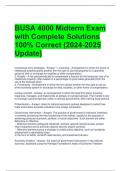BUSA 4000 Midterm Exam
with Complete Solutions
100% Correct (2024-2025
Update)
Contractual entry strategies - Answer- 1. Licensing - Arrangement in which the owner of
intellectual property grants another firm the right to use that property for a specified
period of time in exchange for royalties or other compensation.
2. Royalty - A fee paid periodically to compensate a licensor for the temporary use of its
intellectual property; often based on a percentage of gross sales generated from the
use of the licensed asset
3. Franchising - Arrangement in which the firm allows another firm the right to use an
entire business system in exchange for fees, royalties, or other forms of compensation.
turnkey contract - Answer- an arrangement in which the focal firm plans, finances,
organizes, manages, and implements all phases of a project abroad. Then hands it over
to a foreign customer/sponsor (often a national government), after training local workers
Protectionism - Answer- refers to national economic policies designed to restrict free
trade and protect domestic industries from foreign competition
Government intervention - Answer- The practice of government to intervene (interfere)
in markets, preventing the free functioning of the market, usually for the purpose of
achieving particular economic, political, or social objectives. Such barriers are either
defensive or offensive.
- Defensive barriers safeguard industries, workers, special interest groups, protect
infant industries and to promote national security (export controls)
- Offensive barriers pursue a strategic or public policy objective, such as increasing
employment or generating taxes.
In the form of tariffs, nontariff trade barriers, and investment barriers.
Economic freedom - Answer- the extent of government intervention in the national
economy, assessed using the Heritage Foundation's Index of Economic Freedom
, - most advanced economies are free
- emerging markets are either free or mostly free
- most developing economies are mostly unfree or repressed
Regional integration - Answer- involves groups of countries forming alliances to promote
free trade, cross-national investment, and other mutual goals.
This integration results from economic blocs, in which member countries agree to
eliminate tariffs and other restrictions on the cross-national flow of products, services,
capital, and, in more advanced stages, labor, within the bloc
Stages of regional integration - Answer- - Free trade area: in which tariffs and other
trade barriers are eliminated, to trade in products and services within the bloc, while
each member country maintains an independent international trade policy with countries
outside the bloc.
- Customs union - a free trade area in which common trade barriers are imposed on
nonmember countries
- Common market (single market) - a customs union in which factors of production
move freely among the members, trade barriers are reduced or removed, common
external barriers are established and products, services, and factors of production such
as capital, labor, and technology are allowed to move freely among the member
countries.
- Economic union, a common market in which some economic policies are harmonized
among the member states
- Political union does not yet exist - Perfect unification of all policies by a common
organization- submersion of all separate national institutions
4 general rationale for government intervention - Answer- 1. generate revenue
2. ensure citizen safety, security, and welfare
3. pursue economic, political, or social objectives
4. serve company and industrial interests
4 defensive rationale for government intervention - Answer- 1. protection of the national
economy
2. protection of an infant industry
3. national security
4. national culture and identity
2 offensive rationale for government intervention - Answer- 1. national strategic priorities
2. increasing employment
Tariffs - Answer- - Export tariffs- taxes on products exported by domestic firm
- Import tariff (most common) - tax levied on imported products.
- Ad valorem tariffs are assessed as a percentage of the value of the imported product
- Specific tariff—a flat fee or fixed amount per unit of the imported product—based on
weight, volume, or surface area
- Revenue tariff - intended to raise revenue for the government




